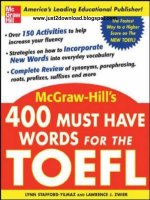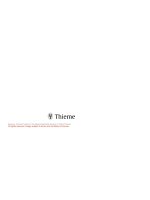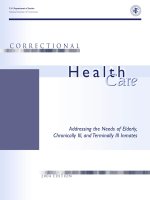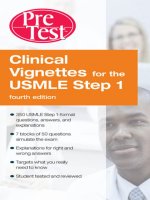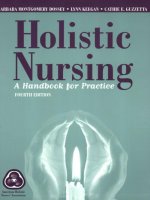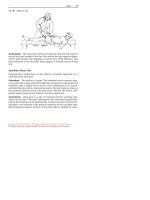Clinical Vignettes for the USMLE Step 1 PreTestTM Self-Assessment and Review Fourth Edition pot
Bạn đang xem bản rút gọn của tài liệu. Xem và tải ngay bản đầy đủ của tài liệu tại đây (3.63 MB, 333 trang )
Clinical Vignettes for the
USMLE Step 1
PreTest
TM
Self-Assessment and Review
Notice
Medicine is an ever-changing science. As new research and clinical experience
broaden our knowledge, changes in treatment and drug therapy are required. The
authors and the publisher of this work have checked with sources believed to be
reliable in their efforts to provide information that is complete and generally in
accord with the standards accepted at the time of publication. However, in view of
the possibility of human error or changes in medical sciences, neither the authors
nor the publisher nor any other party who has been involved in the preparation or
publication of this work warrants that the information contained herein is in every
respect accurate or complete, and they disclaim all responsibility for any errors or
omissions or for the results obtained from use of the information contained in this
work. Readers are encouraged to confirm the information contained herein with
other sources. For example and in particular, readers are advised to check the product
information sheet included in the package of each drug they plan to administer
to be certain that the i nformation contained in this work is accurate and that
changes have not been made in the recommended dose or in the contraindications
for administration. This recommendation is of particular importance in connection
with new or infrequently used drugs.
Clinical Vignettes for the
USMLE Step 1
PreTest
TM
Self-Assessment and Review
Fourth Edition
New York Chicago San Francisco Lisbon London Madrid Mexico City
Milan New Delhi San Juan Seoul Singapore Sydney Toronto
Copyright © 2008 by The McGraw-Hill Companies, Inc. All rights reserved. Manufactured
in the United States of America. Except as permitted under the United States Copyright Act
of 1976, no part of this publication may be reproduced or distributed in any form or by any
means, or stored in a database or retrieval system, without the prior written permission of the
publisher.
0-07-151083-4
The material in this eBook also appears in the print version of this title: 0-07-147184-7.
All trademarks are trademarks of their respective owners. Rather than put a trademark
symbol after every occurrence of a trademarked name, we use names in an editorial fashion
only, and to the benefit of the trademark owner, with no intention of infringement of the
trademark. Where such designations appear in this book, they have been printed with initial
caps.
McGraw-Hill eBooks are available at special quantity discounts to use as premiums and sales
promotions, or for use in corporate training programs. For more information, please contact
George Hoare, Special Sales, at or (212) 904-4069.
TERMS OF USE
This is a copyrighted work and The McGraw-Hill Companies, Inc. (“McGraw-Hill”) and its
licensors reserve all rights in and to the work. Use of this work is subject to these terms.
Except as permitted under the Copyright Act of 1976 and the right to store and retrieve one
copy of the work, you may not decompile, disassemble, reverse engineer, reproduce, modify,
create derivative works based upon, transmit, distribute, disseminate, sell, publish or
sublicense the work or any part of it without McGraw-Hill’s prior consent. You may use the
work for your own noncommercial and personal use; any other use of the work is strictly
prohibited. Your right to use the work may be terminated if you fail to comply with these
terms.
THE WORK IS PROVIDED “AS IS.” McGRAW-HILL AND ITS LICENSORS MAKE NO
GUARANTEES OR WARRANTIES AS TO THE ACCURACY, ADEQUACY OR
COMPLETENESS OF OR RESULTS TO BE OBTAINED FROM USING THE WORK,
INCLUDING ANY INFORMATION THAT CAN BE ACCESSED THROUGH THE
WORK VIA HYPERLINK OR OTHERWISE, AND EXPRESSLY DISCLAIM ANY
WARRANTY, EXPRESS OR IMPLIED, INCLUDING BUT NOT LIMITED TO IMPLIED
WARRANTIES OF MERCHANTABILITY OR FITNESS FOR A PARTICULAR
PURPOSE. McGraw-Hill and its licensors do not warrant or guarantee that the functions con-
tained in the work will meet your requirements or that its operation will be uninterrupted or
error free. Neither McGraw-Hill nor its licensors shall be liable to you or anyone else for any
inaccuracy, error or omission, regardless of cause, in the work or for any damages resulting
therefrom. McGraw-Hill has no responsibility for the content of any information accessed
through the work. Under no circumstances shall McGraw-Hill and/or its licensors be liable
for any indirect, incidental, special, punitive, consequential or similar damages that result
from the use of or inability to use the work, even if any of them has been advised of the
possibility of such damages. This limitation of liability shall apply to any claim or cause
whatsoever whether such claim or cause arises in contract, tort or otherwise.
DOI: 10.1036/0071471847
We hope you enjoy this
McGraw-Hill eBook! If
you’d like more information about this book,
its author, or related books and websites,
please click here.
Professional
Want to learn more?
Contents
Introduction . . . . . . . . . . . . . . . . . . . . . . . . . . . . . . . . . . . . . . . . . . . vii
Questions
Block 1 . . . . . . . . . . . . . . . . . . . . . . . . . . . . . . . . . . . . . . . . . . . . . . . . 1
Block 2 . . . . . . . . . . . . . . . . . . . . . . . . . . . . . . . . . . . . . . . . . . . . . . . 21
Block 3 . . . . . . . . . . . . . . . . . . . . . . . . . . . . . . . . . . . . . . . . . . . . . . . 43
Block 4 . . . . . . . . . . . . . . . . . . . . . . . . . . . . . . . . . . . . . . . . . . . . . . . 67
Block 5 . . . . . . . . . . . . . . . . . . . . . . . . . . . . . . . . . . . . . . . . . . . . . . . 89
Block 6. . . . . . . . . . . . . . . . . . . . . . . . . . . . . . . . . . . . . . . . . . . . . . 113
Block 7. . . . . . . . . . . . . . . . . . . . . . . . . . . . . . . . . . . . . . . . . . . . . . 137
Answers
Block 1. . . . . . . . . . . . . . . . . . . . . . . . . . . . . . . . . . . . . . . . . . . . . . 161
Block 2. . . . . . . . . . . . . . . . . . . . . . . . . . . . . . . . . . . . . . . . . . . . . . 185
Block 3. . . . . . . . . . . . . . . . . . . . . . . . . . . . . . . . . . . . . . . . . . . . . . 207
Block 4. . . . . . . . . . . . . . . . . . . . . . . . . . . . . . . . . . . . . . . . . . . . . . 229
Block 5. . . . . . . . . . . . . . . . . . . . . . . . . . . . . . . . . . . . . . . . . . . . . . 253
Block 6. . . . . . . . . . . . . . . . . . . . . . . . . . . . . . . . . . . . . . . . . . . . . . 275
Block 7. . . . . . . . . . . . . . . . . . . . . . . . . . . . . . . . . . . . . . . . . . . . . . 299
Bibliography . . . . . . . . . . . . . . . . . . . . . . . . . . . . . . . . . . . . . . . . . . 321
v
For more information about this title, click here
This page intentionally left blank
Introduction
The current format of the United States Medical Licensing Examination
Step 1 (USMLE Step 1) exam emphasizes clinical vignettes—in single-best-
answer multiple-choice format—as the only test question. The examina-
tion is 350 questions broken into seven blocks of 50 questions each.
Examinees have one hour to complete each block.
Clinical Vignettes for the USMLE Step 1: Fourth Edition parallels this
format. The book contains 350 clinical vignette-style questions covering
the core basic sciences and was assembled based on the published content
outline for the USMLE Step 1. The questions are divided into 7 blocks of
50 questions. As on the Step 1 exam, each block tests the examinee on all
core basic science areas. Answers are in the second half of the book. Each
answer is accompanied by a concise but comprehensive explanation and is
referenced to a key textbook or journal article for further reading.
The questions in this book were culled from the seven PreTest Basic
Science books. The publisher acknowledges and thanks the following
authors for their contributions to this book:
Anatomy, Histology, and Cell Biology: Robert M. Klein, PhD and George
C. Enders, PhD
Biochemistry and Genetics: Golder Wilson, MD
Microbiology: James D. Kettering, PhD and Hansel M. Fletcher, PhD
Neuroscience: Allan Siegel, PhD
Pathology: Earl J. Brown, MD
Pharmacology: Marshal Shlafer, PhD
Physiology: Patricia Metting, PhD
McGraw-Hill
November 2007
vii
Copyright © 2008 by The McGraw-Hill Companies, Inc. Click here for terms of use.
This page intentionally left blank
Block 1
Questions
1-1. A patient has been referred to your academic medical center because
of recent-onset ventricular ectopy, second degree AV nodal block, chro-
matopsia, and other extracardiac signs and symptoms of digoxin intoxica-
tion. His family doctor, who has been treating him for a host of common
medical problems over the last 30 years, had prescribed furosemide and
digoxin for this gentleman’s heart failure. Blood tests show that serum digoxin
levels are well within a normal range. We believe the problems are diuretic-
induced. Which of the following does the diuretic most likely do to account
for the digoxin toxicity?
a. Caused hypercalcemia
b. Caused hypokalemia
c. Caused hyponatremia
d. Displaced digoxin from tissue binding sites
e. Inhibited digoxin’s metabolic elimination
1-2. A 62-year-old male who was diagnosed with lung cancer also displays
weakness in his arms and legs. A battery of tests are administered to the
patient, including those involving nerve conduction. The nerve conduction
test reveals a reduction in the compound motor action potential relating to
muscles of the hand. However, the amplitude of this potential improves
significantly following exercise involving the relevant muscles. Which of
the following is the most likely diagnosis?
a. MS
b. ALS
c. Myasthenia gravis
d. Lambert-Eaton syndrome
e. MD
1
Copyright © 2008 by The McGraw-Hill Companies, Inc. Click here for terms of use.
1-3. A 29-year-old woman (gravida 3, para 2) gave birth to a healthy baby after
38 weeks of gestation and delivered the intact placenta spontaneously. The preg-
nancy was complicated by preeclampsia, but fetal monitoring and ultrasound
were normal throughout gestation. The predominant structures shown in the
accompanying photomicrograph of the placenta are derived from which of the
following?
2 Clinical Vignettes for the USMLE Step 1
a. A combination of fetal and maternal tissues
b. Endometrial glands
c. Endometrial stroma
d. Fetal tissues
e. Maternal blood vessels
1-4. A 48-year old woman suffering from a severe tension headache is
brought to the Emergency Department after her husband discovered her
unresponsive and barely breathing when he stopped at home from work
during his lunch hour. A bottle of Vicodin was found next to the bathroom
sink. Which of the following arterial blood gases are most consistent with
her clinical presentation?
a. pH = 7.27; PaCO
2
= 60 mmHg, [HCO
3
–
] = 26 mEq/L, Anion Gap = 12 mEq/L
b. pH = 7.02; Pa
CO
2
= 60 mmHg, [HCO
3
–
] = 15 mEq/L, Anion Gap = 12 mEq/L
Block 1 3
c. pH = 7.10; PaCO
2
= 20 mmHg, [HCO
3
–
] = 6 mEq/L, Anion Gap = 30 mEq/L
d. pH = 7.51; Pa
CO
2
= 49 mmHg, [HCO
3
–
] = 38 mEq/L, Anion Gap = 14 mEq/L
e. pH = 7.40; Pa
CO
2
= 20 mmHg, [HCO
3
–
] = 10 mEq/L, Anion Gap = 26 mEq/L
1-5. A 6-month old infant is admitted to the hospital with acute meningi-
tis. The Gram stain reveals gram-positive, short rods, and the mother indi-
cates that the child has received “all” of the meningitis vaccinations. Which
of the following is the most likely cause of the disease?
a. H. influenzae
b. L. monocytogenes
c. N. meningitidis, group A
d. N. meningitidis, group C
e. S. pneumoniae
1-6. An AIDS patient complains of headaches and disorientation. A clini-
cal diagnosis of Toxoplasma encephalitis is made, and Toxoplasma cysts are
observed in a brain section (see figure below). Which of the following anti-
body results would be most likely in this patient?
a. IgM nonreactive, IgG nonreactive
b. IgM nonreactive, IgG reactive (low titer)
c. IgM reactive (low titer), IgG reactive (high titer)
d. IgM reactive (high titer), IgG reactive (high titer)
e. IgM reactive (high titer), IgG nonreactive
1-7. A 14-month-old boy presents with a fever of 102°F. The child has a
longstanding history of recurrent lower respiratory tract infections includ-
ing bronchitis and pneumonia. Chronic diarrhea is a longstanding prob-
lem. His mother reports that she had numerous upper respiratory
infections and chronic diarrhea as a young child. A complete blood count,
lung function tests, and urinalysis values are all within normal range.
Serum immunoglobulin levels are normal for IgG and IgM, but IgA was 25
mg/dL (normal = 40–60 mg/dL). There are numerous neutrophils and
other white cells in the stool sample and the stool is cultured for specific
bacteria. IgA coats pathogens facilitating repulsion of the negative charge
on the cell membrane. That negative charge on the cell membrane is pri-
marily caused by which of the following?
a. Free saccharide groups
b. Glycoprotein
c. Cholesterol
d. Peripheral membrane protein
e. Integrins
1-8. A 47-year-old man presents with headaches, muscle weakness, and
leg cramps. He is not currently taking any medications. Physical examina-
tion finds a thin adult man with mild hypertension. Laboratory examina-
tion reveals slightly increased sodium, decreased serum potassium level,
and decreased hydrogen ion concentration. Serum glucose levels are within
normal limits. A CT scan reveals a large tumor involving the cortex of his
left adrenal gland. Which of the following combinations of serum labora-
tory findings is most likely to be present in this individual?
a. Decreased aldosterone with increased renin
b. Decreased cortisol with decreased ACTH
c. Increased aldosterone with decreased renin
d. Increased cortisol with increased ACTH
e. Increased deoxycorticosterone with increased cortisol
1-9. Following hemisection of the spinal cord at the level of approximately
T3, a patient experiences loss of pain and temperature on the left side of the
leg. Which of the following tracts was affected by the hemisection of the
cord that could account for this deficit?
a. Right fasciculus cuneatus
b. Right fasciculus gracilis
c. Right spinothalamic tract
d. Left spinothalamic tract
e. Left corticospinal tract
4 Clinical Vignettes for the USMLE Step 1
Block 1 5
1-10. A 27-year-old patient with insulin-dependent diabetes mellitus told his
roommate that he could not afford to refill his insulin prescription until he got
a paycheck. The roommate offered to get it for him, but the patient assured him
he could wait until after the weekend. When the roommate returned from a
weekend trip on Sunday evening, he found the man unresponsive on the
couch, and called 9-1-1. Which of the following arterial blood gases taken in
the Emergency Department would be expected in diabetic coma?
a. pH = 7.22; PaCO
2
= 60 mmHg, [HCO
3
–
] = 26 mEq/L, Anion Gap = 12 mEq/L
b. pH = 7.02; Pa
CO
2
= 60 mmHg, [HCO
3
–
] = 15 mEq/L, Anion Gap = 12 mEq/L
c. pH = 7.10; Pa
CO
2
= 20 mmHg, [HCO
3
–
] = 6 mEq/L, Anion Gap = 30 mEq/L
d. pH = 7.51; Pa
CO
2
= 49 mmHg, [HCO
3
–
] = 38 mEq/L, Anion Gap = 14 mEq/L
e. pH = 7.40; Pa
CO
2
= 20 mmHg, [HCO
3
–
] = 10 mEq/L, Anion Gap = 26 mEq/L
1-11. A 63-year-old man presents with signs of congestive heart failure,
including shortness of breath, cough, and paroxysmal nocturnal dyspnea.
Physical examination reveals a hyperdynamic, bounding, “water-hammer”
pulse and a decrescendo diastolic murmur. His hyperdynamic pulse causes
“bobbing” of his head. Which of the following is the most frequent cause of
the cardiac valvular abnormality present in this individual?
a. Aortic dissection
b. Infective endocarditis
c. Latent syphilis
d. Marfan syndrome
e. Rheumatic fever
1-12. An elderly female suffering from an infection complained that she
could not salivate and was unable to display lacrimation on the right side
of her face. Following a neurological examination, it was determined that a
peripheral component of a cranial nerve was affected by this disorder.
Which of the following cell bodies of origin form the origin of the affected
cranial nerve?
a. Dorsal motor nucleus of the vagus
b. Nucleus ambiguus
c. Inferior salivatory nucleus
d. Superior salivatory nucleus
e. Edinger-Westphal nucleus of cranial nerve III
1-13. An immunocompromised person with a history of seizures has an
MRI that reveals a temporal lobe lesion. Brain biopsy results show multin-
ucleated giant cells with intranuclear inclusions. Which of the following is
the most probable cause of the lesion?
a. Coxsackievirus
b. Hepatitis C virus
c. Herpes simplex virus
d. Listeria monocytogenes
e. Parvovirus
1-14. Soon after returning from a trip to Costa Rica, a 41-year-old woman
develops recurrent chills and high fever that recur every 48 h. Examination
of her peripheral blood reveals red granules (Schüffner’s dots) in enlarged,
young erythrocytes. Which of the following organisms is most likely to
have produced her signs and symptoms?
a. Afipia felis
b. Ancyclostoma duodenale
c. B. microti
d. P. ovale
e. Toxoplasma gondii
1-15. A 22-year-old woman presents at the ophthalmology clinic. She
describes an initial inability to drive at night because of what she describes as
“night blindness.” She says that the deterioration of her vision has continued
and she is having difficulty seeing objects on the periphery of her vision.
Visual acuity, color, visual field, dark adaptation, and ERG testing is com-
pleted. The tests show rod degeneration with limited peripheral vision. She
has pigment deposits in the mid-peripheral retina known as “bone spicules.”
She also has attenuated vessels in the retina and paleness of the optic nerves.
An electroretinogram (ERG) is reduced in amplitude. The cause may be
related to a failure of opsin and other protein vesicle transport. This transport
would occur along which of the following?
a. Microfilaments (thin filaments)
b. Thick filaments
c. Microtubules
d. Intermediate filaments
e. Spectrin heterodimers
1-16. A 57-year-old woman is undergoing a femoral popliteal bypass for
her peripheral vascular disease. The vascular surgeon wishes to induce a
localized arteriolar constriction to help control hemostasis. An increase in
6 Clinical Vignettes for the USMLE Step 1
Block 1 7
the local concentration of which of the following agents will cause systemic
vasoconstriction?
a. Nitric oxide
b. Angiotensin II
c. Atrial natriuretic peptide
d. A b
2
-adrenergic agonist
e. Adenosine
1-17. We administer a drug with the intent of lowering a patient’s elevated
LDL and total cholesterol levels, and raising HDL levels. The drug we choose
inhibits cholesterol synthesis by inhibiting 3-hydroxy-3-methylglutaryl-
coenzyme A (better known as [HMG CoA] reductase). Which of the fol-
lowing drugs best fits this description and works by the stated mechanism
of action?
a. Clofibrate
b. Gemfibrozil
c. Lovastatin
d. Nicotinic acid (niacin)
e. Probucol
1-18. A parent is correcting his child’s photograph for red eye and notes
one of the child’s pupils reflects the flash as white rather than red. An oph-
thalmologist confirms the presence of a tumor in the back of the white-
reflecting eye, telling the parents about the possibility of retinoblastoma
(180200). The parents return to their pediatrician, confused about the rela-
tion of retinoblastoma (Rb) and B-cell lymphoma (bcl) genes they saw on
the Internet and the possibility their child’s tumor is inherited. Which of
the following is the most appropriate response?
a. Rb and bcl proteins are polymerases that prevent oncogenesis by stringent DNA
repair; the parents are therefore carriers for autosomal recessive Rb deficiency
with a 1 in 4 recurrence risk.
b. Rb protein binds transcription factors needed for cell division and bcl protein
(cyclin D1) stimulates it; Rb is a tumor suppressor gene requiring homozygous
mutations (two hits) that are likely sporadic in a child with unilateral tumor.
c. Rb and bcl proteins are DNA-binding factors that suppress promoters near
oncogenes and act as tumor suppressors; the child represents a new, dominant-
acting mutation and the parents have a minimal recurrence risk.
d. Rb protein stimulates cyclins specific for retinal tissue and bcl does the same for
lymphatic cyclins; the child represents a new mutation with excess Rb activity.
e. Rb protein forms complexes with bcl protein that promotes cell division in
rapidly proliferating tissues; the child represents a new mutation with excess
Rb-bcl complex activity.
1-19. A 48-year-old woman presents with a 1.5-cm firm mass in the upper
outer quadrant of her left breast. A biopsy from this mass reveals many of
the ducts to be filled with atypical cells. In the center of these ducts there
is extensive necrosis. No invasion into the surrounding fibrous tissue is
seen. Which of the following is the most likely diagnosis?
a. Colloid carcinoma
b. Comedocarcinoma
c. Infiltrating ductal carcinoma
d. Infiltrating lobular carcinoma
e. Lobular carcinoma in situ
1-20. A forest worker experiences a sudden onset of fever, headache,
myalgias, and prostration. A macular rash develops several days later, with
it appearing first on the hands and feet before moving onto his trunk.
Which of the following treatments is most appropriate?
a. Amphoteracin B
b. Cephalosporin
c. Erythromycin
d. Sulfonamides
e. Tetracycline
1-21. A 29-year-old woman presents with nervousness, heat intolerance,
and weight loss. Physical examination reveals the presence of exophthal-
mus, pretibial myxedema, and diffuse enlargement of the thyroid. Labora-
tory examination reveals elevated serum thyroxine (T4) and
triiodothyronine (T3) levels, while the level of serum thyroid-stimulating
hormone (TSH) is decreased. Histologic sections from her thyroid gland
reveal increased cellularity with scalloping of the colloid at the margins of
the follicles. Which of the following types of autoantibodies is most specific
for this individual disease?
a. Antimicrosomal antibodies
b. Antithyroglobulin antibodies
c. Antithyroid peroxidase antibodies
d. TSH-receptor-blocking antibodies
e. TSH-receptor-stimulating antibodies
1-22. A 27-year-old woman presents with tender cervical lymphadenopa-
thy. A biopsy of one of the enlarged lymph nodes in this area is diagnosed
by the pathologist as being a “reactive lymph node with follicular hyper-
plasia.” The associated schematic depicts the morphology of this reactive
change. The majority of the proliferating cells in the area marked by the
8 Clinical Vignettes for the USMLE Step 1
Block 1 9
arrow labeled with an “*” are in the process of transforming into cells that
eventually will secrete which substance?
a. Erythropoietin
b. Gamma-interferon
c. Immunoglobulin
d. Interleukin-2
e. Interleukin-3
1-23. A 65-year-old man presents to the neurology clinic with a several
year history in which he has less and less energy and spontaneity, memory
loss (especially recent events), and mood swings. He is described by his wife
as uncharacteristically slow to learn and react and shying away from any-
thing new, preferring the familiar, confused, getting lost easily, and exercis-
ing poor judgment. He scores poorly on the mini-mental status examination
(MMSE). This disease is believed to be caused by protein misfolding. Chap-
eronins regulate protein folding in which of the following ways?
a. Stimulating aggregation of proteins
b. Contributing folding information to the native protein
c. Controlling the docking of the signal peptide with its receptor on the rough
endoplasmic reticulum
d. Inhibiting proteolytic activity of misfolded proteins
e. Using their ATPase activity to bind and release themselves from hydrophobic
regions of the protein
1-24. A 17-year-old boy is admitted to the hospital with a traumatic brain
injury, sustained when he fell off his motorcycle. He develops a fever of
39°C, which is unrelated to an infection or inflammation. The fever is most
likely due to a lesion of which of the following?
a. The lateral hypothalamus
b. The arcuate nucleus
c. The posterior nucleus
d. The paraventricular nucleus
e. The anterior hypothalamus
1-25. A 3-year-old girl, with no history of vaccination, is brought to the hos-
pital with a sore throat, fever, malaise, and difficulty breathing. Physical
examination reveals a gray membrane covering the pharynx. Growth of the
etiologic agent on cysteine-tellurite agar forms gray to black colonies with a
brown halo. The major virulence factor of this organism is only produced by
those strains that will most likely have which of the following characteristics?
a. Encapsulated
b. Glucose fermenters
c. Lysogenic for β-prophage
d. Of the mitis strain
e. Sucrose fermenters
1-26. A patient with epilepsy is started on oral therapy with an appropriate
anticonvulsant. Not long after treatment starts he manifests psychotic behav-
iors that were not present before antiepileptic drug therapy started. Of the
following antiepileptic agents, which is associated with the highest risk of
causing psychosis?
a. Ethosuximide
b. Phenobarbital
c. Phenytoin
d. Valproic acid
e. Vigabatrin
1-27. A newborn boy is born with first arch congenital malformations
classified as Treacher-Collins syndrome, which is an autosomal dominant
inherited disorder. The Treacher Collins-Franceschetti syndrome 1 (TCOF)
gene encodes the protein treacle. Treacle is localized to the structure
labeled with the arrows in the accompanying transmission electron micro-
graph. Treacle is most likely involved in which of the following?
10 Clinical Vignettes for the USMLE Step 1
Block 1 11
a. Assembly of ribosomal subunits into mature ribosomes
b. Translation of cytosolic proteins
c. Transcription of nuclear proteins
d. Transcription of ribosomal proteins
e. Organelle degradation
1-28. A 34-year-old man with mild anxiety and depression symptoms has
heard about buspirone on television and asks whether it might be suitable for
him. According to the latest diagnostic criteria, the drug would be appropri-
ate, particularly for short-term symptom control. Which of the following best
describes an important property of this drug?
a. Associated with a withdrawal syndrome that, if unsupervised, is frequently lethal
b. Has a significant potential for abuse
c. Is likely to potentiate the CNS depressant effects of alcohol, benzodiazepines,
and sedative antihistamines (e.g., diphenhydramine), so such interactants must
be avoided at all cost
d. Requires almost daily dosage titrations in order to optimize the response
e. Seldom causes drowsiness
1-29. A 47-year-old female is brought to the Emergency Department
because she fainted at the gym during her daily aerobic workout. A promi-
nent systolic murmur is heard and a presumptive diagnosis of aortic steno-
sis is made. Which of the following is consistent with that diagnosis?
a. A decreased pulse pressure
b. An increased arterial pressure
c. A decreased left ventricular diastolic pressure
d. An increased ejection fraction
e. A decreased cardiac oxygen consumption
1-30. A 5-year-old Egyptian boy receives a sulfonamide antibiotic as pro-
phylaxis for recurrent urinary tract infections. Although he was previously
healthy and well-nourished, he becomes progressively ill and presents to
your office with pallor and irritability. A blood count shows that he is
severely anemic with jaundice due to hemolysis of red blood cells. Which
of the following is the simplest test for diagnosis?
a. Northern blotting of red blood cell mRNA
b. Enzyme assay of red blood cell hemolysate
c. Western blotting of red blood cell hemolysates
d. Amplification of red blood cell DNA and hybridization with allele-specific
oligonucleotides (PCR-ASOs)
e. Southern blot analysis for gene deletions
1-31. An 11-year-old boy presents with ciliary dyskinesia, sinusitis, and
bronchiectasis. He has had persistent infections and otitis media since
birth. A PA radiograph shows dextrocardia, and he has a negative saccha-
rin test. In the cross-section of the cilium shown below, which of the fol-
lowing is primarily affected in this disorder?
12 Clinical Vignettes for the USMLE Step 1
Block 1 13
a. Structure A
b. Structure B
c. Structure C
d. Structure D
e. Structure E
1-32. Two weeks after contact with an individual with an acute disease
presentation, a 12-year-old girl has fever and malaise, followed by a rash
composed of crops of vesicles which lasts 5 days. This common childhood
disease is caused by which of the following viruses?
a. Adenovirus
b. Cytomegalovirus
c. Papillomavirus
d. Rubeola
e. Varicella virus
1-33. A 2-day-old neonate becomes lethargic and uninterested in breast-
feeding. Physical examination reveals hypotonia (low muscle tone), muscle
twitching that suggests seizures, and tachypnea (rapid breathing). The
child has a normal heartbeat and breath sounds with no indication of car-
diorespiratory disease. Initial blood chemistry values include normal glu-
cose, sodium, potassium, chloride, and bicarbonate (HCO
3
–
) levels; initial
blood gas values reveal a pH of 7.53, partial pressure of oxygen (Po
2
) nor-
mal at 103 mmHg, and partial pressure of carbon dioxide (Pco
2
) decreased
at 27 mmHg. Which of the following treatment strategies is most
appropriate?
a. Administer alkali to treat metabolic acidosis
b. Administer alkali to treat respiratory acidosis
c. Decrease the respiratory rate to treat metabolic acidosis
d. Decrease the respiratory rate to treat respiratory alkalosis
e. Administer acid to treat metabolic alkalosis
1-34. A patient is sent to be examined by an endocrinologist after com-
plaining of excessive thirst and increased excretion of urine. The patient is
then referred to a neurologist and neuroradiologist, who detect the pres-
ence of a secondary brain lesion after viewing an MRI of the patient’s brain.
Where is the most likely locus of the lesion that could account for these
deficits?
14 Clinical Vignettes for the USMLE Step 1
a. A
b. B
c. C
d. D
e. E
f. F
g. G
h. H
Block 1 15
1-35. A 32-year-old woman presents at her physician’s office complaining
of nausea and vomiting. The history reveals that her symptoms have been
present for over a month and that they seem to be worse in the morning.
A urine sample is taken and shows that the woman is pregnant. Physiological
changes that occur during pregnancy include which of the following?
a. Decreased production of cortisol and corticosterone
b. Increased conversion of glucose to glycogen
c. Hypercapnia
d. Increased hematocrit
e. Reduced circulating gonadotropin levels
1-36. After a term uncomplicated gestation, normal delivery, and unre-
markable nursery stay, a 10-day-old female is readmitted to the hospital
because of poor feeding, weight loss, and rapid heart rate. Antibiotics are
started as a precaution against sepsis, and initial testing indicates an
unusual echocardiogram with a very short PR interval and a large heart on
x-ray. Initial concern about a cardiac arrhythmia changes when a large
tongue is noted, causing concern about glycogen storage disease type II
(Pompe disease—232300—Table 3). Which of the following best explains
why Pompe disease is more severe and lethal compared to other glycogen
storage diseases?
a. The deficiency is a degradative rather than synthetic enzyme
b. The deficiency involves a liver enzyme
c. The deficiency involves a lysosomal enzyme
d. The deficiency causes associated neutropenia
e. The deficiency involves a serum enzyme
1-37. A 45-year-old woman presents with increasing fatigue, weakness,
and tingling of her arms and legs. Physical examination finds numbness
and loss of balance, position, and vibratory sense in both of her lower
extremities. Histologic examination of a smear made from a bone marrow
aspiration reveals asynchrony in red blood cell precursors between the
maturation of their nuclei and their cytoplasm. Additional workup discov-
ers achlorhydria, and a biopsy of the antrum of her stomach reveals chronic
atrophic gastritis. Which of the following is the most likely diagnosis?
a. Fanconi anemia
b. Leukoerythroblastic anemia
c. Megaloblastic anemia
d. Myelophthisic anemia
e. Sideroblastic anemia
